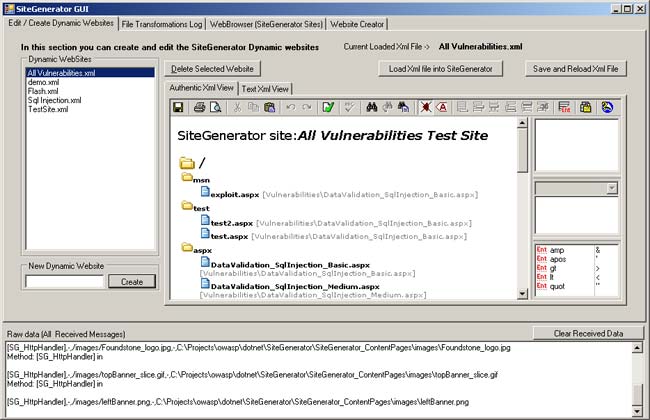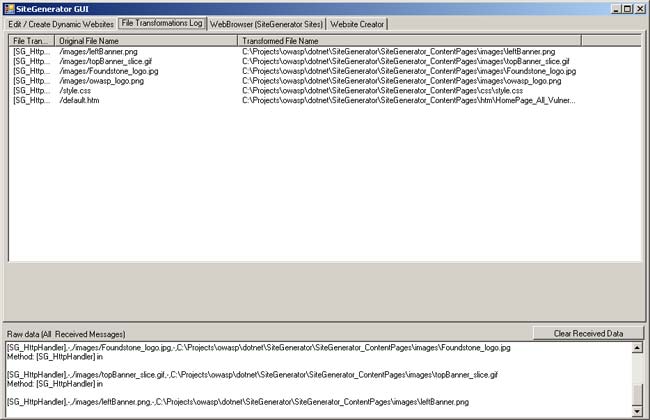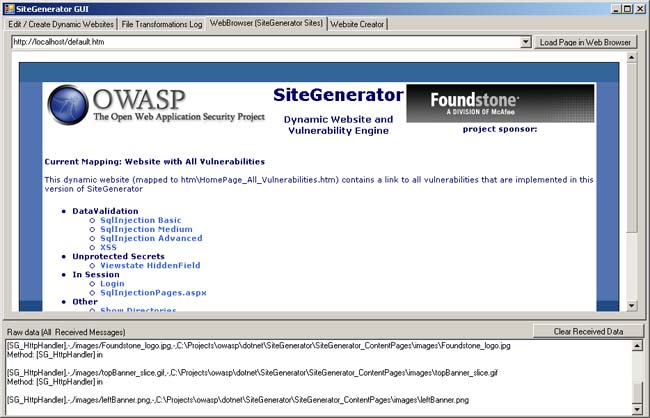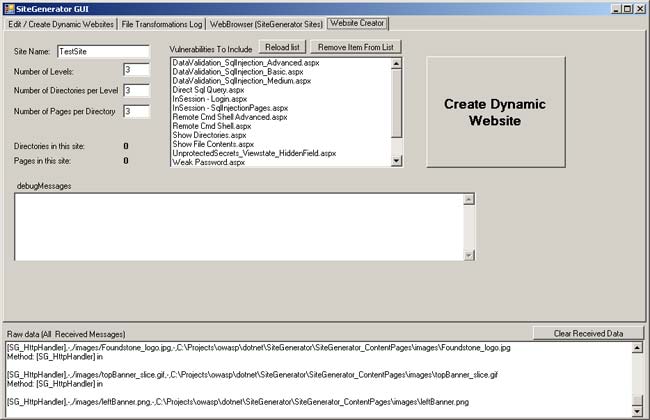This site is the archived OWASP Foundation Wiki and is no longer accepting Account Requests.
To view the new OWASP Foundation website, please visit https://owasp.org
OWASP SiteGenerator
| |
|
|---|---|

|
Main
Current Version: 0.80 (Public Beta)
Sponsor: Foundstone & SPI Dynamics & OWASP Spring of Code 2007
OWASP Site Generator's SpoC 007 Progress Page
Description
OWASP SiteGenerator allows the creating of dynamic websites based on XML files and predefined vulnerabilities (some simple, some complex) covering .Net languages and web development architectures (for example, navigation: Html, Javascript, Flash, Java, etc...).
Uses
- Evaluation of Web Application Security Scanners
- Evaluation of Web Application Firewalls
- Developer Training
- Web Honeypots
- Web Application hacking contests (or evaluations)
- Whatever your mind can come up with!
Downloads
- Installer: SiteGenerator Installer (Version 0.80) - Updated 03/05/2007
- Source Code: Current_SiteGenerator_Source.zip (Version 0.80)
Accessing SVN for SiteGenerator
- One way is to browse the SVN online by going to the SiteGenerator Source Tree
- Another way is to configure your SVN client to download the source locally.
Installation and configuration notes
- Before you install the website portion please confirm the following.
- There is an application pool that is configured to run under the System account
- A website that is pointed to where you want the Site Generatorator web portion to be installed
- Configure the website to run Asp.Net 2.0
- Make sure there is an application for that website and have it set to the application pool created in the first step
- Add a IIS wildcard Application Mapping (accessible via Home Directory -> Configuration) to C:\WINDOWS\Microsoft.NET\Framework\v2.0.50727\aspnet_isapi.dll and untick the 'Verify that file exists'
- Note: On Windows XP the OK button might appear disable. You will need to browse to the file and then select the location and also put a dot in from of the asterik (i.e. .*) for the OK button to be enabled
- Make sure Default.htm is one of the files included in the default document list (in the 'Documents' tab)
- Configure the Website's IP Address to be 127.0.0.1, and click on the Advanced button to add a new host header mapping
- Run the Installer
- Point the website's document root to the install dir\sitegenerator_contentpages and make sure the IIS user has correct permissions
- Click on the SiteGenerator link that was placed on your desktop
If all goes well you now can browse to your localhost and see the
default SiteGenerator's website. If you see a blank page, try
http://<SITE NAME>/Default.htm (you might be getting a cached version of
http://<SITE NAME>)
Note that the SQL Injection vulnerabilities expect that you have the latest version of HacmeBank (v2.0) installed in your box.
Introduction to SiteGenerator
- This tool has been sponsored by Foundstone, BUT (and it is a big but) it is being released under the Owasp .Net Project and an Open Source Licence. So Kudos for Foundstone for doing this and I hope they get good exposure from it
- The main objective of the tool is to create dynamic websites based on XML files which will 'map' to a database containing hundreds of different vulnerabilities (some simple to detect/exploit, some harder) covering multiple
languages and web development architectures (for example navigation: Html, JavaScript, Flash, Java, etc...)
- There are many ways this tool can be used, here are just a couple starting ideas:
- As a training tool since it allows the creation of multiple websites with multiple variations of vulnerabilities
- As a Web Application Honeypot (since we are able to create dynamic ( i.e. false) websites and track / monitor in real-time all requests made)
- As a test ground for newly discovered vulnerabilities types and its exploit vectors
- As a benchmark for Web Security Scanners
- The Web Security Scanner benchmarking and testing is the most obvious short-term application for this tool, but I think that as it evolves the others will be proven to be as (if not more) valuable
- On the Web Security Scanner issue:
- My main hope is that the Web Security Scanner Companies will see this tool as an opportunity and work with the Owasp .Net project (and other groups that want to be involved) in a productive and constructive way
- Although in the short term some Web Security Scanners might have some bad results (well, at least when compared with what their Marketing machine publishes :) in the medium term, as they adapt and improve their scanning techniques, everybody will benefit
- One of the core objectives of the tool (when thinking about benchmarking Web Security Scanners) is to be able to create real and measurable metrics. For example:
- Scanner X was able to detect 65% of the vulnerabilities where Scanner Y was able to detect 90%
- Scanner X made 10000 to detect those 65% (over a period of 16h) where scanner Y made 4000 request (over a period of 10h)
- 20% of Scanner X results where false positives, where Scanner Y had 50% false positives
- Scanner X was able to deal with Html and JavaScript navigation, Scanner Y was able to deal with Html, JavaScript and Flash, and both where NOT able to deal with Java based navigation systems
- Scanner X is not able to go more than 40 levels deep, Scanner Y is able to go up at least 100 levels deep (if not more)
- etc, etc, etc
- There will be two main types of tests that can be done in the short term:
- Provide the links to all different types of vulnerabilities existent in the database, and see how many can the scanner correctly identify? and
- When multiple types of website architectures and navigation techniques are used, how many vulnerabilities is the scanner able to detect?
- In order to test (and further improve the tool) I want to take this opportunity to ask the Web Application Security Scanners that subscribe to this list (which I believe all do) to give the Owasp .Net project a temporary licence to their product so that we can use it during development and during some basic benchmarking that we might do (and NO, I will not sign an NDA that doesn't allow me to publish the data collected, in fact I will not sign ANY NDA with ANY web application security scanner company)
- Note that at the moment I (Dinis) have no plans to do a full benchmarking exercise since I don't have the time required, but I know of at least one group of experienced security consultants which is starting such project (and I will be supporting them). If anybody else is interested in doing a similar benchmarking project please contact me directly
- Regarding how the tool works, here is a brief technical description:
There are two main components: A webserver (which can be IIS or a custom webserver) and a GUI application (written in C# 2.0). The GUI Application is responsible for handling all mappings (from the virtual requests to the actual pages on disk). The two main components talk over tcp on port 4,000, the GUI application listens for requests from the web server and then returns an answer to the webserver
The current version is hardcoded to IIS, although in the code there is support for using a custom .Net webserver. This IIS version uses an HttpHander to capture all requests and communicate with the GUI Application (called SiteGeneratorGUI)
The dynamic websites are defined by XML files like this (which are edited on the GUI Application using the WYSIWYG Altova Authentic Browser Object (SPS files created via Altova's StyleVision application)):
<?xml version="1.0" encoding="utf-8" ?>
<SiteGenerator name="SiteGenerator Demo" xmlns:ipo="http://www.altova.com/IPO"
xmlns="http://www.xmlspy.com/schemas/orgchart" xmlns:xsi="http://www.w3.org/2001/XMLSchema-instance">
<site>
<folder name="">
<file mappedTo="aspx/Default.aspx" name="HelloWorld.aspx" />
<folder name="htm" />
<folder name="aspx">
<file mappedTo="aspx/pages.htm" name="pages.htm" />
<file mappedTo="aspx/xss.aspx" name="xss.aspx" />
<file mappedTo="aspx/SqlInjection_Easy.aspx" name="SqlInjection.aspx" />
<file mappedTo="aspx/SqlInjection_Hard.aspx" name="SqlInjection2.aspx" />
</folder>
<folder name="flash">
<file mappedTo="flash/cromas_xml.swf" name="cromas_xml.swf" />
<file mappedTo="flash/cromas_xml.htm" name="menu.htm" />
<file mappedTo="/flash/cromas_menu.xml" name="cromas_menu.xml" />
</folder>
</folder>
</site>
</SiteGenerator>
SiteGeneratorGUI.exe and IIS will map the virtual name "HelloWorld.aspx" to the file on disk "aspx/Default.aspx" . For example:
http://localhost/HelloWorld.aspx --> F:\Owasp SiteGenerator\SiteGenerator_ContentPages\aspx\Default.aspx
So to create new websites all you need to do is to create a new XML file
Then to create new vulnerabilities type, all you need to create in an Aspx page and map it to the xml file
How To Use SiteGenerator
SiteGenerator contains four different screens that can be used they are further explained below. In all of the screen shots you will see a bottom pane this contains all the information that is flowing from the website to the fat client. Clicking on "Clear Received Data" will clear out the bottom text area and the information found on the file transformations log tab.
Edit / Create Dynamic Websites Tab
This area allows users to create a basic website that could be used. You can also remove a website and modify it using the word like widget.
Select the root path for the site "/" you can choose the default page this can be another page that you have previously mapped or a specific path to a file.
File Transformations Log
This tab allows a user to see how the transformations are working. For example you could make sure that the new mapping for f00.aspx actually was converted to /test123/test.aspx.
Web Browser Tab
This tab will allow for a user to browse to the generated website instead of using a normal browser.
Website Creator Tab
This tab allows a user to initially create the files for a given website.
Development Notes
Project Identification
| PROJECT INFO What does this OWASP project offer you? |
RELEASE(S) INFO What does this OWASP project release offer you? | ||||||||||||||||||||||
|---|---|---|---|---|---|---|---|---|---|---|---|---|---|---|---|---|---|---|---|---|---|---|---|
|
| ||||||||||||||||||||||



